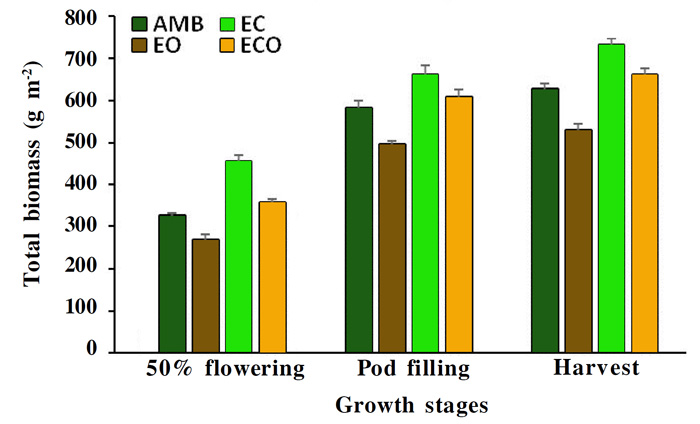| Tweet | Follow @co2science |
Paper Reviewed
Singh, R.N., Mukherjee, J., Sehgal, V.K., Bhatia, A., Krishnan, P., Das, D.K., Kumar, V. and Harit, R. 2017. Effect of elevated ozone, carbon dioxide and their interaction on growth, biomass and water use efficiency of chickpea (Cicer arietinum L.). Journal of Agrometeorology 19: 301-305.
Chickpea (Cicer arietinum) is the third most important legume crop. It is currently grown on approximately 11.5 million hectares around the world, although most all of that production (96%) is in developing countries. Yet despite such agricultural prominence, very few studies have investigated the potential impacts of climate change on chickpea. And thus it became the recent objective of Singh et al. (2017) to examine the combined effects of elevated CO2 and elevated ozone on the growth, biomass and water use efficiency of this important crop.
Their experiment was conducted outdoors at the Free Air Ozone and Carbon Dioxide Enrichment (FAOCE) facility at the Indian Agricultural Research Institute in New Delhi, India (28.58°N, 77.20°E, 228.16 m). Forty days after sowing, chickpea plants (cv. Pusa 5023) were subjected to one of four different atmospheric treatments from 0700-1800 hours daily until the end of the growing season: normal air (AMB = 400 ppm CO2, 30 ppb O3), elevated ozone (EO = 400 ppm CO2, 70 ppb O3), elevated CO2 (EC = 550 ppm CO2, 30 ppb O3) and elevated CO2 and ozone (ECO = 550 ppm CO2, 70 ppb O3). Several growth and development parameters were then measured (or calculated from measurements) at various time intervals until the conclusion of the experiment, including crop phenology, plant height, aboveground biomass, crop growth rate, relative growth rate and water use efficiency. It was anticipated that elevated concentrations of ozone -- a plant stressor -- would negatively impact chickpea growth, whereas elevated concentrations of carbon dioxide -- a plant nutrient -- would enhance it.
In discussing their findings, Singh et al. report that both elevated CO2 and elevated O3 advanced plant phenological development, shortening the growth period by about 10 days and 14 days, respectively, compared to ambient conditions, albeit due to different mechanisms (elevated CO2 sped up the development and likely induced earlier senescence, whereas elevated O3 typically damages leaf chlorophyll content and nutrient status to enhance senescence).
Not surprisingly, the eight scientists also report that plant growth was improved in the elevated CO2 treatment. Chickpea plant height, growth rate, aboveground biomass (see figure below), seed yield and water use efficiency all benefited from the approximate 37% increase in atmospheric carbon dioxide. In contrast, each of these parameters were negatively impacted by elevated ozone concentrations. And when in combination, the positive effects of elevated CO2 were strong enough to completely ameliorate the negative impacts of elevated O3. Compared to ambient conditions, for example, seed yield was enhanced by 32% in the EC treatment, reduced by 22% in the EO treatment, but increased by 10% in the ECO treatment. Similarly, water use efficiency increased by 44% in the EC treatment, declined by 22% in the EO treatment, but experienced a 5% increase in the ECO treatment.
In light of all of the above findings, it is clear that rising concentrations of atmospheric CO2 will benefit the growth and yield of chickpea plants, including those areas of the globe that experience high levels of tropospheric ozone pollution, which areas may well shrink in size in the future as developing countries continue to modernize and improve their pollution control systems. As a result, this important legume will continue to be a key factor in providing ongoing food security for much of the developing world.

Figure 1. Chickpea aboveground biomass at different growth stages for plants growing under normal air (AMB = 400 ppm CO2, 30 ppb O3), elevated ozone (EO = 400 ppm CO2, 70 ppb O3), elevated CO2 (EC = 700 ppm CO2, 30 ppb O3) and elevated CO2 and ozone (ECO = 700 ppm CO2, 70 ppb O3). Source: Singh et al. (2017).




